 |
 |
The five battleships of the TENNESSEE and COLORADO Classes came to be known as the "Big Five." These ships, TENNESSEE, CALIFORNIA, COLORADO, MARYLAND and WEST VIRGINIA represented the culmination of the development of the American dreadnought battleship, and were the epitome of the American battleship between the world wars. Unlike the rest of the battle line, their unique and characteristic silhouette of two evenly spaced cage masts and funnels, was little changed between the time they entered service in the early 1920's until December 1941. As a result of that, and their place at the head of the battle line, they came to represent the American battleship between the wars, just as after the war, the IOWA’s came to represent the American battleship as most people know it today. But between the Big Five, and the fast battleships of World War II, was a whole change in thinking and design. The fast battleships that followed the Big Five were far different from what had gone before them.
This photo article presents a few models of the Big Five during that era. Models of these ships in 1200 and 1250 scales have been made by many companies from the 1920's through the 1970's, including Bassett Lowke, Wiking, TreMo, South Salem, Besarabis (shown here), Comet/Authenticast, Delphin, and Navis.
Several of the models depicted here are conversions from the Navis models, and show the progression of changes to the ships prior to the end of 1941. The Navis models depict the ships as built. Unfortunately there are no models of these ships as modified during the period prior to 1942 that are of the same level of quality as the two Navis models. So if the collector wants models of that quality has to do his own conversions. The conversions show the following changes:
WEST VIRGINIA in the mid-1920's with a catapult and light boom aft. This was a simple conversion, the only changes being the addition of the catapult and the boom.
COLORADO about 1937 with substantial changes to the bridge, two catapults, heavier aircraft crane aft, changes to the boats nested by the bridge, and antiaircraft platforms on both fighting tops. The increase in the size of the bridge, as well as other additions tended to make the ships look heftier, like they were on steroids.
CALIFORNIA in late 1941, also with numerous changes to the bridge area, fighting tops, as well as addition of a CXAM (by Navalis) on the bridge. On this model the removal of the searchlight platform around the aft funnel was necessary, which was a major cutting, grinding and sanding job. The conversion of this model is depicted in a series of photos here. One can see from these the significant amount work and additional parts needed to complete this model. I would not recommend this or the COLORADO conversion for anyone without substantial previous experience at this type of work.
Finally there is the Cy Broman MARYLAND December 1941, hand made wood model with real hand wound wire cage masts.